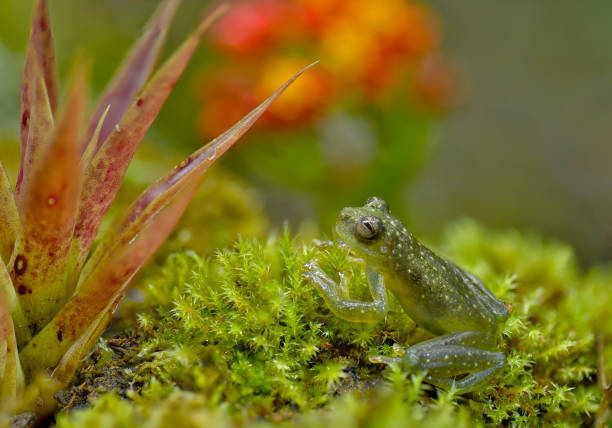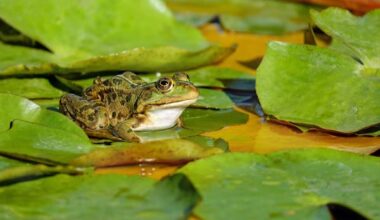Ever wondered about what are the tiny frogs in my yard? Those quick, hopping beings you see in your garden or lawn? Discover the fascinating world of these micro-amphibians that have made your backyard their home.
We’re talking about tiny frogs, these pint-sized wonders with a voracious appetite for pesky insects and an uncanny ability to blend into their surroundings. Their minute size makes them elusive little spectacles in the grand theatre of nature. As dusk falls, their symphony fills the air—a gentle lullaby sung by what seems like invisible minstrels.
Do come along as we hop over leafy greens and slinky vines to uncover secrets from this hidden universe – where even the tiniest critter plays a monumental role. Are you ready? Because it’s time for us to leap deeper into…the fabulous world of frogs!

Identifying the Tiny Frogs in Your Yard
When you spot those tiny, hopping creatures in your yard, it’s natural to wonder what species they are. Identifying tiny frogs can be a fun and educational activity for both adults and children.
These petite amphibians come in various colors and patterns, making them fascinating to observe.
One simple way to identify them is by examining their physical characteristics. Pay attention to their size, coloration, skin texture, and any unique markings or patterns they may have. Additionally, listen closely to their calls as different frog species produce distinct sounds.
Another effective method is using field guides or online resources that provide detailed descriptions and images of different frog species.
These references often include information about the frogs’ distribution range – which helps narrow down your options based on your location.
If you’re struggling with identification even after attempting these methods, consider reaching out to local wildlife experts or herpetologists who can offer assistance based on their expertise.
Habitat and Behavior of Small Frogs
Tiny frogs are typically found near bodies of water such as ponds, streams, or even small garden ponds where they lay their eggs.
They prefer moist environments with vegetation that offers shelter from predators like birds and snakes while providing ideal hunting grounds for insects.
These diminutive amphibians are most active during warm weather conditions when temperatures are conducive to their survival. You might notice them hopping around on damp leaves after rain showers or basking under sunlight during cooler days.
Frogs communicate through calls which vary between species; some produce high-pitched chirps while others emit deep croaks.
This vocalization serves multiple purposes including attracting mates during breeding seasons and warding off potential predators.
Interestingly enough, tiny frogs play a crucial role within ecosystems due to their diet consisting mainly of insects. By consuming a significant number of pests such as mosquitoes and flies, they help maintain the natural balance in your yard and garden.

Different Species of Tiny Frogs Commonly Found in Yards
1. American Toad (Anaxyrus americanus)
These small toads can be found across North America and are identifiable by their bumpy skin, warty appearance, and golden eyes.
2. Spring Peeper (Pseudacris crucifer)
Known for their distinct “peep” call heard during springtime, these tiny frogs have smooth skin with dark crossbands on their backs.
3. Gray Treefrog (Hyla versicolor)
As the name suggests, these treefrogs are typically grayish in color but can change shades depending on environmental conditions to blend into their surroundings better.
4. Cricket Frog (Acris crepitans)
These minuscule frogs are excellent jumpers often seen near water bodies or moist areas with tall grasses; they produce short calls resembling a cricket’s chirp.
5. Pacific Chorus Frog (Pseudacris regilla)
Native to the western regions of North America including California and Oregon, these small greenish-brown frogs emit loud chorus-like calls during breeding season evenings.
6. Green Treefrog (Hyla cinerea)
With vibrant green bodies adorned with white patches under each eye, these delightful little amphibians inhabit trees near swamps or marshy areas throughout the southeastern United States.
7. Southern Leopard Frog (Lithobates sphenocephalus utricularius)
Sporting distinctive spots all over their body combined with a range of colors from brown to bright green, these frog species often dwell around ponds or slow-moving streams.
8. European Common Frog (Rana temporaria):
A widespread species found across Europe including the UK, they come in various colors and have a unique yellow or green patch on their back.
9. Green and Golden Bell Frog (Litoria aurea)
Native to Australia, these vividly colored frogs with their striking markings can be found near freshwater habitats such as streams or shallow lakes.
10. Banjo Frog (Limnodynastes dumerilii)
Known for their distinctive banjo-like call heard after rainfall, these stout-bodied frogs are common in eastern Australia and prefer moist environments.
Biology and Lifecycles of Tiny Frogs
Understanding the biology and lifecycles of tiny frogs can further enhance your appreciation for these fascinating creatures. Most frog species go through four distinct life stages:
a. egg
b. tadpole
c. metamorphosis
d. adult frog
Females lay gelatinous egg masses in water bodies where they will hatch into tadpoles within a few days or weeks depending on the species. Tadpoles have gills to breathe underwater but gradually develop lungs as they undergo metamorphosis.
During metamorphosis, tadpoles transform into miniature versions of adult frogs by growing limbs, absorbing their tails, developing lungs for breathing air instead of water, and undergoing internal organ transformations required for terrestrial life.
Once fully transformed into froglets or young frogs resembling adults but smaller in size, they leave the water systems seeking shelter under rocks or vegetation near ponds.
From there they venture out further into yards searching for suitable habitats to establish themselves as full-grown adults, capable of mating during future breeding seasons.
Role of Tiny Frogs in Ecosystem and Biodiversity
Tiny frogs play a vital role within ecosystems by contributing to biodiversity conservation efforts.
As predators feeding primarily on insects like mosquitoes that can transmit diseases such as West Nile virus or Zika virus to humans – they help control insect populations which serves multiple benefits:
1. Reduced pest population
By feeding on garden pests, tiny frogs act as free pest control agents, reducing the need for chemical interventions which can harm beneficial insects and disrupt the ecosystem.
2. Pollination
Some frog species also serve a pollination role by transferring pollen on their skin or through accidental ingestion when feeding on nectar-rich flowers.
3. Prey base for larger animals
Frogs represent an essential food source for various predators including birds, snakes, and other carnivorous animals further up the food chain.

Indicators of Frog Presence: Spotting Eggs and Tadpoles
Spotting eggs and tadpoles in your yard is an exciting sign that tiny frogs have made themselves at home. Depending on the species, frog eggs may appear in clusters or strings attached to vegetation near water sources like ponds or shallow pools after mating takes place.
Furthermore, tadpoles are often found swimming together in groups known as schools; they can be observed nibbling algae or plant matter present within their aquatic environments while undergoing metamorphosis into adult frogs.
If you stumble upon these indicators during your exploration, congratulations – it means your yard provides a suitable habitat conducive to supporting small amphibian life!
Potential Hazards or Benefits to Having Tiny Frogs in Your Yard
While having tiny frogs in your yard offers numerous benefits such as natural pest control and contributing to overall biodiversity, there are some potential concerns worth considering:
1. Excessive noise: Certain frog species produce loud calls during mating season evenings which might bother individuals seeking quiet surroundings.
2. Health risks: Although rare, some frogs secrete toxins through their skin as a defense mechanism – handling them without proper precautions could potentially cause skin irritation or allergic reactions in susceptible individuals.
3. Attraction of predators: The presence of small amphibians may attract predators like snakes or large predatory birds to your yard since they view them as a readily available food source; if you have small pets, take necessary precautions.
Methods to Attract or Deter Frogs from Your Garden
If you’re keen on attracting frogs to your garden, consider implementing the following practices:
1. Create a water feature: Install a small pond or provide shallow dishes of water in shaded areas where frogs can deposit their eggs and tadpoles can thrive.
2. Plant native vegetation: Native plant species attract insects that serve as food sources for frogs while providing adequate shelter and suitable habitats.
3. Reduce pesticide use: Minimize chemical pesticide usage as it can harm both frog populations and their prey base.
Conversely, if you want to deter frogs due to specific reasons such as noise concerns, implement the following measures:
1. Reduce standing water sources: Eliminate stagnant water sources like old buckets or containers that could act as breeding grounds for tiny frogs.
2. Modify lighting conditions: Bright lights near ponds might discourage certain frog species from congregating due to disrupted natural light patterns during nighttime hours when they are most active.
Remember, striking a balance between attracting or deterring tiny frogs depends on personal preferences and consideration of various factors unique to your yard’s environment!
Conclusion
Overall, discovering these delightful creatures hopping around your yard provides a valuable opportunity to connect with nature and appreciate the intricate lives of even the smallest inhabitants sharing our living spaces.
Embrace this enchanting experience by learning more about local frog species while contributing positively towards maintaining ecological harmony!
FAQs
Q: What are the tiny frogs in my yard?
A: The tiny frogs in your yard are most likely to be juvenile toads. Although they are commonly referred to as frogs, they are actually small toads.
Q: Do tiny toads eat bugs?
A: Yes, tiny toads are voracious eaters and they love to feast on all kinds of bugs. They are excellent at controlling the insect population in your yard.
Q: How many tiny toads can I find in my yard?
A: It is common to find dozens, or even hundreds, of tiny toads hopping around in your yard. They tend to appear in large numbers, especially after a rainstorm.
Q: Can I tell if a tiny toad is a frog or a toad?
A: It can be challenging to differentiate between a tiny toad and a frog at a glance. However, tiny toads usually have dry, bumpy skin, while frogs have smooth, moist skin.
Q: What happens to the tiny toads as they grow?
A: As the tiny toads grow, they undergo metamorphosis and eventually become adult toads. So, those little guys hopping around in your yard are actually baby toads.
Q: Why don’t I ever see the tiny toads’ parents?
A: Adult toads are excellent at hiding and often stay away from human activity. They may prefer to live in damp, grassy areas or wetlands, away from prying eyes.
Q: Can tiny toads migrate like birds or deer?
A: Tiny toads do not migrate long distances like birds or deer. However, they may move within a couple of meters from their birthplace in search of food and suitable habitat.
Q: How do tiny toads get around without seeing well?
A: Tiny toads have special adaptations, such as large toe pads and the ability to sense vibrations, that help them navigate their surroundings despite their limited vision.
Q: Do tiny toads lay their eggs in water?
A: Yes, like all frogs and toads, tiny toads lay their eggs in water. They need a wet environment for their eggs to develop and for their young to undergo metamorphosis.
Q: What is the life cycle of a tiny toad?
A: The life cycle of a tiny toad starts with eggs laid in water. The eggs hatch into tadpoles, which eventually metamorphose into tiny toadlets and grow into adult toads.

